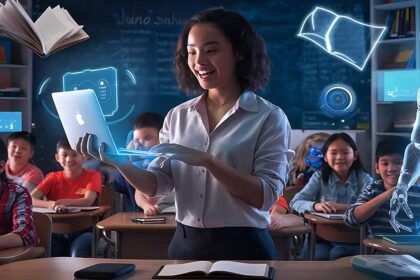Education is a cornerstone of societal development, and access to quality education has long been considered a fundamental right. However, despite its importance, access to education has not always been equitable. Traditionally, barriers such as geographic location, socio-economic status, and lack of resources have kept millions of students from reaching their full potential.
In the 21st century, technology has emerged as a powerful tool capable of bridging these gaps and revolutionizing access to education across the globe. From the rise of online learning platforms to innovations in mobile education and artificial intelligence, technology is reshaping the educational landscape in ways that were once unimaginable.
This article will explore how technology is transforming education, breaking down traditional barriers, and creating new opportunities for learners everywhere. We will also look at the challenges and ethical considerations that accompany these advancements and the steps required to ensure that the benefits of technology in education reach everyone.
1. Democratizing Education: The Role of Online Learning
One of the most significant ways that technology is changing education is through the proliferation of online learning platforms. Historically, access to education was limited to those who could attend physical schools, universities, or specialized training centers. Today, online platforms offer students the ability to learn from anywhere in the world, making education more accessible than ever before.
Massive Open Online Courses (MOOCs)
Massive Open Online Courses (MOOCs) have become an essential part of the modern education ecosystem. Platforms like Coursera, edX, Khan Academy, and Udemy offer free or low-cost courses from top universities and institutions worldwide. These courses cover a wide range of subjects, from basic literacy to advanced scientific research, and allow students to gain knowledge without the need to leave their homes. For example, Harvard University, MIT, and other prestigious institutions offer MOOCs on a variety of subjects, opening up educational opportunities that were previously reserved for a select few.
MOOCs have helped bridge the education gap in several ways. They offer flexibility, allowing students to learn at their own pace and on their own schedule. This flexibility is especially crucial for people living in remote areas or those with limited access to traditional education facilities. Additionally, these platforms often provide certificates of completion, giving students a credential that can improve their employment prospects or contribute to career development.
Self-paced Learning
The ability to learn at your own pace is another key benefit of online education. Unlike traditional classrooms, where students must keep up with the pace set by their teacher, online learning platforms often allow students to choose when and how fast they want to learn. This self-directed learning approach is especially beneficial for adult learners, working professionals, or those with unique learning needs.
The freedom to learn independently can also help bridge the gap for learners who might feel left behind in traditional classrooms. Personalized learning systems, powered by AI, can adapt to a student’s needs, offering content tailored to their level of understanding. This means that even students with learning challenges can move forward in their education without feeling overwhelmed.
2. Mobile Learning: Education in the Palm of Your Hand
In many parts of the world, mobile phones have become the primary means of accessing the internet. This presents an incredible opportunity to use mobile devices as vehicles for learning, particularly in underdeveloped regions where computers and internet infrastructure may be scarce.
Mobile Education Apps
Mobile education apps have surged in popularity, providing students with a flexible, portable learning experience. Applications like Duolingo, Quizlet, Photomath, and Google Classroom have revolutionized how students learn, offering everything from language learning and flashcards to math problem-solving tools.
For example, Duolingo provides a free language-learning platform that anyone with a smartphone can access. It has helped millions of people, including those in remote or underserved areas, learn new languages that would otherwise be inaccessible to them.
In countries like India, where mobile phones are widely used, mobile learning has become an essential tool for delivering educational content to students. Educational apps can deliver lessons and quizzes, provide video tutorials, and offer interactive content, all through the convenience of a smartphone. This model is particularly advantageous for students in rural areas, where educational institutions may be far away, or access to teachers may be limited.
Text Message-Based Learning
In regions with limited access to the internet or expensive data plans, text message-based learning offers a viable solution. Platforms like M-Guru and Text to Teach provide educational content via SMS, helping students access learning materials without requiring an internet connection. These services deliver lessons directly to students’ phones, ensuring that education reaches even the most remote locations.
3. Artificial Intelligence (AI): Tailoring Education to the Individual
AI is having a transformative impact on education, particularly in how learning is personalized and delivered. AI’s ability to collect and analyze data allows it to tailor learning experiences to each student’s individual needs, helping to close achievement gaps and enhance educational outcomes.
Personalized Learning
AI-powered learning platforms like DreamBox, Knewton, and Squirrel AI use machine learning algorithms to assess students’ strengths and weaknesses, adapting lessons to meet their specific needs. These platforms track students’ progress and dynamically adjust difficulty levels in real-time. This ensures that students are appropriately challenged and not left behind in areas where they may struggle.
Personalized learning also helps students who have learning disabilities or are at risk of falling behind. AI-driven tools can identify patterns in students’ performance and provide tailored exercises to address gaps in knowledge. As a result, students receive more focused attention, making learning more accessible and effective.
Automated Grading and Feedback
In addition to personalized learning, AI has streamlined administrative tasks like grading and providing feedback. Tools like Gradescope and Turnitin allow educators to automatically grade assignments, essays, and exams, providing immediate feedback to students. This not only saves teachers time but also allows students to receive prompt and constructive feedback on their work, helping them improve quickly.
For students in under-resourced environments, the ability to receive instant feedback can significantly enhance the learning experience, ensuring they stay on track without waiting days or weeks for grades to be returned.
4. Bridging the Education Gap with Global Collaboration
Technology is also enabling unprecedented levels of collaboration and knowledge-sharing across borders. Online platforms allow students from diverse regions to collaborate on projects, engage in discussions, and share ideas, bridging the gap between cultures and regions.
Global Classrooms and Virtual Exchange Programs
Initiatives like Skype in the Classroom and Global Classroom Project bring students from around the world together for cross-cultural exchanges. These virtual learning environments help foster empathy, understanding, and global citizenship among students, allowing them to learn from one another and solve problems together. Through virtual exchange programs, students can engage with peers from different countries, participate in collaborative projects, and develop a global perspective.
This kind of collaboration can help bridge the education gap between developed and developing nations, creating opportunities for students from different backgrounds to learn from each other. It can also provide students from disadvantaged regions with access to diverse educational resources, perspectives, and expertise that they may not have access to locally.
5. Challenges and Considerations
While technology offers immense potential in improving access to education, there are challenges to address. Digital equity remains a major issue, as many regions lack the infrastructure to support high-speed internet, and many students do not have access to the necessary devices to engage in online learning. This digital divide must be addressed if we are to ensure that technological advancements in education are accessible to all students, regardless of their background or location.
Furthermore, data privacy and security concerns are paramount when it comes to the use of technology in education. The collection and storage of sensitive student data need to be handled responsibly, and policies must be put in place to protect this information from misuse.
Finally, while technology can provide students with personalized learning experiences, it is important that it does not replace the human element of education. Teachers and educators will always play an essential role in providing mentorship, emotional support, and guidance, and technology should serve as a tool to enhance—not replace—their efforts.
Conclusion
Technology is undeniably revolutionizing education, making learning more accessible, personalized, and flexible than ever before. From online courses and mobile apps to AI-powered platforms and global collaboration, technology has the power to bridge gaps and provide opportunities to learners everywhere.
While challenges such as digital equity and data privacy remain, the potential of technology to expand access to quality education is immense. By continuing to innovate and invest in digital tools and resources, we can help ensure that all students, regardless of their socio-economic status or geographic location, have the opportunity to reach their full potential.
Key Takeaways:
- Online learning platforms, MOOCs, and mobile apps have democratized education, providing global access to knowledge and learning resources.
- AI and machine learning are personalizing education, helping students progress at their own pace and receive tailored support.
- Mobile devices are bridging the education gap in remote and underserved regions, making learning accessible to students on the go.
- Global collaboration tools are fostering cross-cultural exchanges and promoting a more inclusive educational environment.
- Addressing challenges like digital equity and data privacy will be key to ensuring that technology benefits all learners equally.





